Laser-Induced Intracellular Delivery: Exploiting Gold-Coated Spiky Polymeric Nanoparticles and Gold Nanorods under Near-Infrared Pulses for Single-Cell Nano-Photon-Poration
Abstract
:1. Introduction
2. Experimental Section
2.1. Materials and Reagents
2.2. High-Aspect-Ratio Gold-Coated Spiky Polymeric Nanoparticles (Au-PNPs) and Gold Nanorods (GNRs) Fabrication
2.3. Au-PNPs and GNRs Modification with Thiol-PEG-Carboxylate
2.4. Characterization of Au-PNPs and GNRs
2.5. Cell Culture
2.6. Fluorescence Microscopy
2.7. Experimental Procedure
2.8. Image Analysis
2.9. Statistical Analysis
3. Results and Discussion
3.1. Au-PNP-PEG- and GNR-PEG-Mediated Intracellular Delivery
3.2. Impact of Au-PNPs and GNRs Concentration, Exposure Time, and Laser Fluence on Delivery Efficiency and Cell Viability of Cells
3.3. Intracellular Delivery of Molecular Dye (PI) and Dextran 3000
3.4. Cell Viability Test on Different Days
4. Conclusions
Supplementary Materials
Author Contributions
Funding
Data Availability Statement
Acknowledgments
Conflicts of Interest
References
- Gurunathan, S.; Kang, M.-H.; Kim, J.-H. A Comprehensive Review on Factors Influences Biogenesis, Functions, Therapeutic and Clinical Implications of Exosomes. Int. J. Nanomed. 2021, 16, 1281. [Google Scholar] [CrossRef]
- Uvizl, A.; Goswami, R.; Gandhi, S.D.; Augsburg, M.; Buchholz, F.; Guck, J.; Mansfeld, J.; Girardo, S. Efficient and Gentle Delivery of Molecules into Cells with Different Elasticity via Progressive Mechanoporation. Lab Chip 2021, 21, 2437–2452. [Google Scholar] [CrossRef] [PubMed]
- Leamon, C.P.; Low, P.S. Delivery of Macromolecules into Living Cells: A Method That Exploits Folate Receptor Endocytosis. Proc. Natl. Acad. Sci. USA 1991, 88, 5572–5576. [Google Scholar] [CrossRef] [PubMed]
- Ghosh, S.; Brown, A.M.; Jenkins, C.; Campbell, K. Viral Vector Systems for Gene Therapy: A Comprehensive Literature Review of Progress and Biosafety Challenges. Appl. Biosaf. 2020, 25, 7–18. [Google Scholar] [CrossRef] [PubMed]
- Chong, Z.X.; Yeap, S.K.; Ho, W.Y. Transfection Types, Methods and Strategies: A Technical Review. PeerJ 2021, 9, e11165. [Google Scholar] [CrossRef]
- Santra, T.S.; Chang, H.-Y.; Wang, P.-C.; Tseng, F.-G. Impact of Pulse Duration on Localized Single-Cell Nano-Electroporation. Analyst 2014, 139, 6249–6258. [Google Scholar] [CrossRef]
- Santra, T.S.; Wang, P.-C.; Chang, H.-Y.; Tseng, F.-G. Tuning Nano Electric Field to Affect Restrictive Membrane Area on Localized Single Cell Nano-Electroporation. Appl. Phys. Lett. 2013, 103, 233701. [Google Scholar] [CrossRef]
- Barriers and Strategies of Cationic Liposomes for Cancer Gene Therapy—PMC. Available online: https://www.ncbi.nlm.nih.gov/pmc/articles/PMC7452052/ (accessed on 13 November 2023).
- van der Loo, J.C.M.; Wright, J.F. Progress and Challenges in Viral Vector Manufacturing. Hum. Mol. Genet. 2016, 25, R42–R52. [Google Scholar] [CrossRef]
- Mehier-Humbert, S.; Guy, R.H. Physical Methods for Gene Transfer: Improving the Kinetics of Gene Delivery into Cells. Adv. Drug Deliv. Rev. 2005, 57, 733–753. [Google Scholar] [CrossRef]
- Kim, K.; Ah Kim, J.; Lee, S.-G.; Gu Lee, W. Seeing the Electroporative Uptake of Cell-Membrane Impermeable Fluorescent Molecules and Nanoparticles. Nanoscale 2012, 4, 5051–5058. [Google Scholar] [CrossRef]
- Meacham, J.M.; Durvasula, K.; Degertekin, F.L.; Fedorov, A.G. Physical Methods for Intracellular Delivery: Practical Aspects from Laboratory Use to Industrial-Scale Processing. SLAS Technol. 2014, 19, 1–18. [Google Scholar] [CrossRef] [PubMed]
- Gupta, P.; Kar, S.; Kumar, A.; Tseng, F.-G.; Pradhan, S.; Mahapatra, P.S.; Santra, T.S. Pulsed Laser Assisted High-Throughput Intracellular Delivery in Hanging Drop Based Three Dimensional Cancer Spheroids. Analyst 2021, 146, 4756–4766. [Google Scholar] [CrossRef] [PubMed]
- Stevenson, D.J.; Gunn-Moore, F.J.; Campbell, P.; Dholakia, K. Single Cell Optical Transfection. J. R. Soc. Interface 2010, 7, 863–871. [Google Scholar] [CrossRef] [PubMed]
- Fan, Q.; Hu, W.; Ohta, A.T. Efficient Single-Cell Poration by Microsecond Laser Pulses. Lab Chip 2015, 15, 581–588. [Google Scholar] [CrossRef] [PubMed]
- Sengupta, A.; Kelly, S.C.; Dwivedi, N.; Thadhani, N.; Prausnitz, M.R. Efficient Intracellular Delivery of Molecules with High Cell Viability Using Nanosecond-Pulsed Laser-Activated Carbon Nanoparticles. ACS Nano 2014, 8, 2889–2899. [Google Scholar] [CrossRef] [PubMed]
- Gayathri, R.; Kar, S.; Nagai, M.; Mahapatra, P.S.; Santra, T.S. Massively Parallel High-Throughput Single-Cell Patterning and Large Biomolecular Delivery in Mammalian Cells Using Light Pulses. Small 2023, 19, e2303053. [Google Scholar] [CrossRef]
- Huang, X.; Jain, P.K.; El-Sayed, I.H.; El-Sayed, M.A. Gold Nanoparticles: Interesting Optical Properties and Recent Applications in Cancer Diagnostics and Therapy. Nanomedicine 2007, 2, 681–693. [Google Scholar] [CrossRef]
- Chen, J.; Wiley, B.; Li, Z.-Y.; Campbell, D.; Saeki, F.; Cang, H.; Au, L.; Lee, J.; Li, X.; Xia, Y. Gold Nanocages: Engineering Their Structure for Biomedical Applications. Adv. Mater. 2005, 17, 2255–2261. [Google Scholar] [CrossRef]
- Huang, X.; El-Sayed, M.A. Gold Nanoparticles: Optical Properties and Implementations in Cancer Diagnosis and Photothermal Therapy. J. Adv. Res. 2010, 1, 13–28. [Google Scholar] [CrossRef]
- Hleb, E.Y.; Lapotko, D.O. Photothermal Properties of Gold Nanoparticles under Exposure to High Optical Energies. Nanotechnology 2008, 19, 355702. [Google Scholar] [CrossRef]
- Amendola, V.; Pilot, R.; Frasconi, M.; Maragò, O.M.; Iatì, M.A. Surface Plasmon Resonance in Gold Nanoparticles: A Review. J. Phys.: Condens. Matter 2017, 29, 203002. [Google Scholar] [CrossRef] [PubMed]
- Lukianova-Hleb, E.; Hu, Y.; Latterini, L.; Tarpani, L.; Lee, S.; Drezek, R.A.; Hafner, J.H.; Lapotko, D.O. Plasmonic Nanobubbles as Transient Vapor Nanobubbles Generated around Plasmonic Nanoparticles. ACS Nano 2010, 4, 2109–2123. [Google Scholar] [CrossRef] [PubMed]
- Yu, S.-Y.; Tu, C.-H.; Liaw, J.-W.; Kuo, M.-K. Laser-Induced Plasmonic Nanobubbles and Microbubbles in Gold Nanorod Colloidal Solution. Nanomaterials 2022, 12, 1154. [Google Scholar] [CrossRef] [PubMed]
- Sabzeghabae, A.N.; Devia-Cruz, L.F.; Gutierrez-Herrera, E.; Camacho-Lopez, S.; Aguilar, G. Bubble Dynamics of Laser-Induced Cavitation in Plasmonic Gold Nanorod Solutions and the Relative Effect of Surface Tension and Viscosity. Opt. Laser Technol. 2021, 134, 106621. [Google Scholar] [CrossRef]
- Laser-Induced Vapor Nanobubbles for Efficient Delivery of Macromolecules in Live Cells. Available online: https://www.spiedigitallibrary.org/conference-proceedings-of-spie/9338/1/Laser-induced-vapor-nanobubbles-for-efficient-delivery-of-macromolecules-in/10.1117/12.2078895.full?SSO=1 (accessed on 14 November 2023).
- Laser Pulse Duration Is Critical for the Generation of Plasmonic Nanobubbles—PMC. Available online: https://www.ncbi.nlm.nih.gov/pmc/articles/PMC4082386/ (accessed on 14 November 2023).
- Excitation of Nanoscale Vapor Bubbles at the Surface of Gold Nanoparticles in Water|The Journal of Chemical Physics|AIP Publishing. Available online: https://pubs.aip.org/aip/jcp/article/124/18/184702/937324/Excitation-of-nanoscale-vapor-bubbles-at-the (accessed on 14 November 2023).
- Santra, T.S.; Kar, S.; Chen, T.-C.; Chen, C.-W.; Borana, J.; Lee, M.-C.; Tseng, F.-G. Near-Infrared Nanosecond-Pulsed Laser-Activated Highly Efficient Intracellular Delivery Mediated by Nano-Corrugated Mushroom-Shaped Gold-Coated Polystyrene Nanoparticles. Nanoscale 2020, 12, 12057–12067. [Google Scholar] [CrossRef] [PubMed]
- Xiong, R.; Samal, S.K.; Demeester, J.; Skirtach, A.G.; De Smedt, S.C.; Braeckmans, K. Laser-Assisted Photoporation: Fundamentals, Technological Advances and Applications. Adv. Phys. X 2016, 1, 596–620. [Google Scholar] [CrossRef]
- Shinde, A.; Kar, S.; Nagai, M.; Tseng, F.-G.; Santra, T.S. Light-Induced Cellular Delivery and Analysis. In Handbook of Single Cell Technologies; Santra, T.S., Tseng, F.-G., Eds.; Springer: Singapore, 2020; pp. 1–29. ISBN 978-981-10-4857-9. [Google Scholar]
- Smith, A.M.; Mancini, M.C.; Nie, S. Second Window for in Vivo Imaging. Nat. Nanotechnol. 2009, 4, 710–711. [Google Scholar] [CrossRef] [PubMed]
- Weissleder, R. A Clearer Vision for in Vivo Imaging. Nat. Biotechnol. 2001, 19, 316–317. [Google Scholar] [CrossRef]
- Molecular Dynamics Investigation of Nanoscale Cavitation Dynamics | The Journal of Chemical Physics | AIP Publishing. Available online: https://pubs.aip.org/aip/jcp/article/141/23/234508/194290/Molecular-dynamics-investigation-of-nanoscale (accessed on 14 November 2023).
- Brujan, E.-A. Stress Wave Emission from Plasmonic Nanobubbles. J. Phys. D Appl. Phys. 2016, 50, 015304. [Google Scholar] [CrossRef]
- Boulais, E.; Lachaine, R.; Hatef, A.; Meunier, M. Plasmonics for Pulsed-Laser Cell Nanosurgery: Fundamentals and Applications. J. Photochem. Photobiol. C Photochem. Rev. 2013, 17, 26–49. [Google Scholar] [CrossRef]
- Kolwas, K.; Derkachova, A. Impact of the Interband Transitions in Gold and Silver on the Dynamics of Propagating and Localized Surface Plasmons. Nanomaterials 2020, 10, 1411. [Google Scholar] [CrossRef] [PubMed]
- Barman, T.; Hussain, A.A.; Sharma, B.; Pal, A.R. Plasmonic Hot Hole Generation by Interband Transition in Gold-Polyaniline. Sci. Rep. 2015, 5, 18276. [Google Scholar] [CrossRef]
- Mohamed Alshangiti, D.; Mohamady Ghobashy, M.; Alqahtani, H.A.; El-damhougy, T.K.; Madani, M. The Energetic and Physical Concept of Gold Nanorod-Dependent Fluorescence in Cancer Treatment and Development of New Photonic Compounds|review. RSC Adv. 2023, 13, 32223–32265. [Google Scholar] [CrossRef] [PubMed]
- Mackey, M.A.; Ali, M.R.K.; Austin, L.A.; Near, R.D.; El-Sayed, M.A. The Most Effective Gold Nanorod Size for Plasmonic Photothermal Therapy: Theory and In Vitro Experiments. J. Phys. Chem. B 2014, 118, 1319–1326. [Google Scholar] [CrossRef] [PubMed]
- Ray, P.C.; Yu, H.; Fu, P.P. Toxicity and Environmental Risks of Nanomaterials: Challenges and Future Needs. J. Environ. Sci. Health Part. C 2009, 27, 1–35. [Google Scholar] [CrossRef] [PubMed]
- Abbasi, R.; Shineh, G.; Mobaraki, M.; Doughty, S.; Tayebi, L. Structural Parameters of Nanoparticles Affecting Their Toxicity for Biomedical Applications: A Review. J. Nanopart. Res. 2023, 25, 43. [Google Scholar] [CrossRef] [PubMed]
- Borah, R.; Kumar, A.; Samantaray, M.; Desai, A.; Tseng, F.-G. Photothermal Heating of Au Nanorods and Nanospheres: Temperature Characteristics and Strength of Convective Forces. Plasmonics 2023, 18, 1449–1465. [Google Scholar] [CrossRef]
- Micromachines |Free Full-Text| Visible Pulsed Laser-Assisted Selective Killing of Cancer Cells with PVP-Capped Plasmonic Gold Nanostars. Available online: https://www.mdpi.com/2072-666X/14/6/1173 (accessed on 14 November 2023).
- Lombard, J.; Biben, T.; Merabia, S. Threshold for Vapor Nanobubble Generation Around Plasmonic Nanoparticles. J. Phys. Chem. C 2017, 121, 15402–15415. [Google Scholar] [CrossRef]
- Mohan, L.; Hattori, R.; Zhang, H.; Matsumura, Y.; Santra, T.S.; Shibata, T.; Ryu, S.; Nagai, M. Effect of Size and Interparticle Distance of Nanoparticles on the Formation of Bubbles Induced by Nanosecond Laser. Surf. Interfaces 2022, 30, 101820. [Google Scholar] [CrossRef]
- Santra, T.S.; Tseng, F.G. Recent Trends on Micro/Nanofluidic Single Cell Electroporation. Micromachines 2013, 4, 333–356. [Google Scholar] [CrossRef]
- Uggeri, J.; Gatti, R.; Belletti, S.; Scandroglio, R.; Corradini, R.; Rotoli, B.M.; Orlandini, G. Calcein-AM Is a Detector of Intracellular Oxidative Activity. Histochem. Cell Biol. 2000, 122, 499–505. [Google Scholar] [CrossRef] [PubMed]
- Ma, H.; Xing, F.; Zhou, Y.; Yu, P.; Luo, R.; Xu, J.; Xiang, Z.; Maria Rommens, P.; Duan, X.; Ritz, U. Design and Fabrication of Intracellular Therapeutic Cargo Delivery Systems Based on Nanomaterials: Current Status and Future Perspectives. J. Mater. Chem. B 2023, 11, 7873–7912. [Google Scholar] [CrossRef] [PubMed]
- Stewart, M.P.; Langer, R.; Jensen, K.F. Intracellular Delivery by Membrane Disruption: Mechanisms, Strategies, and Concepts. Chem. Rev. 2018, 118, 7409–7531. [Google Scholar] [CrossRef] [PubMed]
- Goodman, B.E. Transport of Small Molecules across Cell Membranes: Water Channels and Urea Transporters. Adv. Physiol. Educ. 2002, 26, 146–157. [Google Scholar] [CrossRef]
- Chattaraj, A.; Youngstrom, M.; Loew, L.M. The Interplay of Structural and Cellular Biophysics Controls Clustering of Multivalent Molecules. Biophys. J. 2019, 116, 560–572. [Google Scholar] [CrossRef]
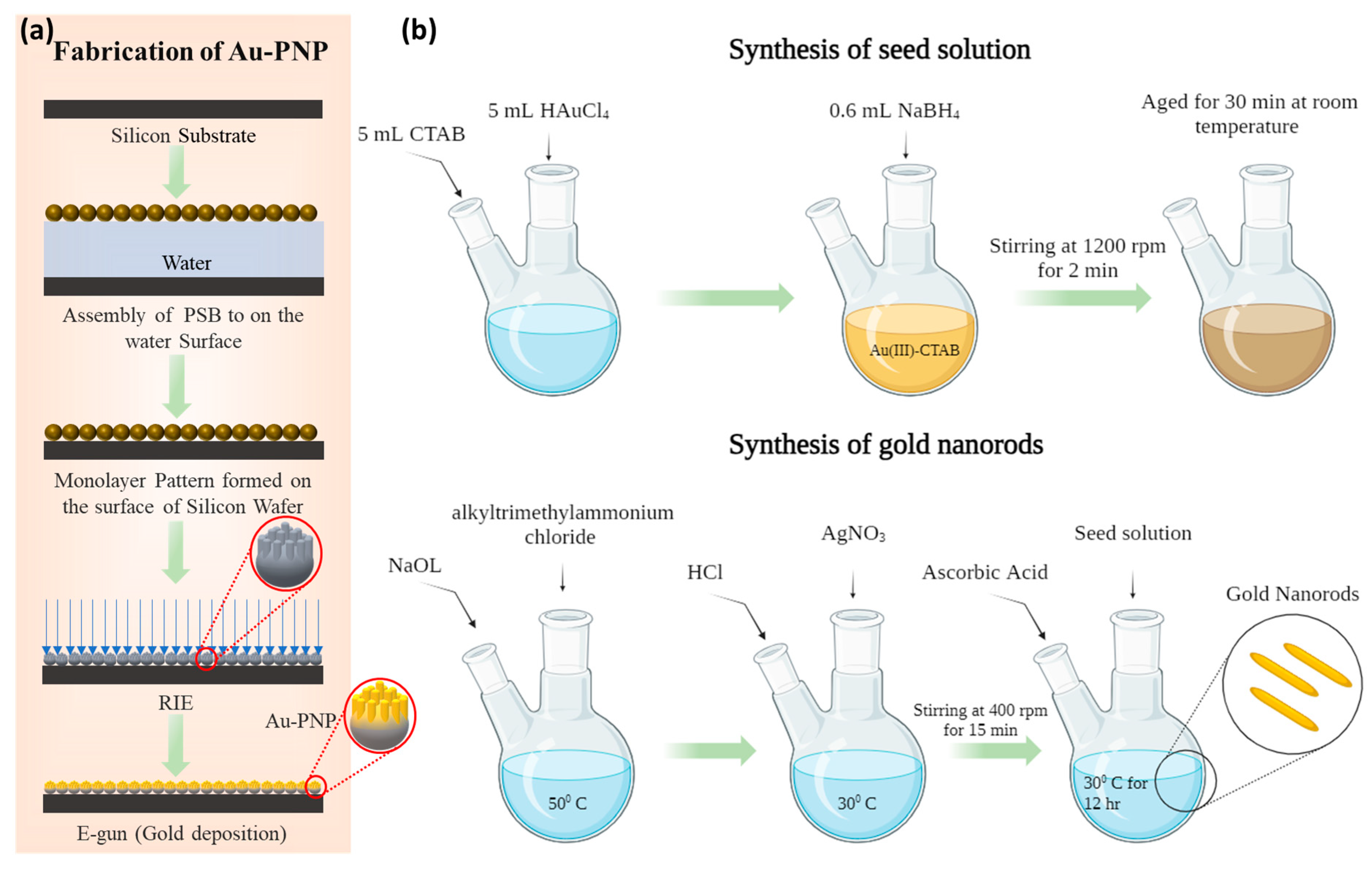
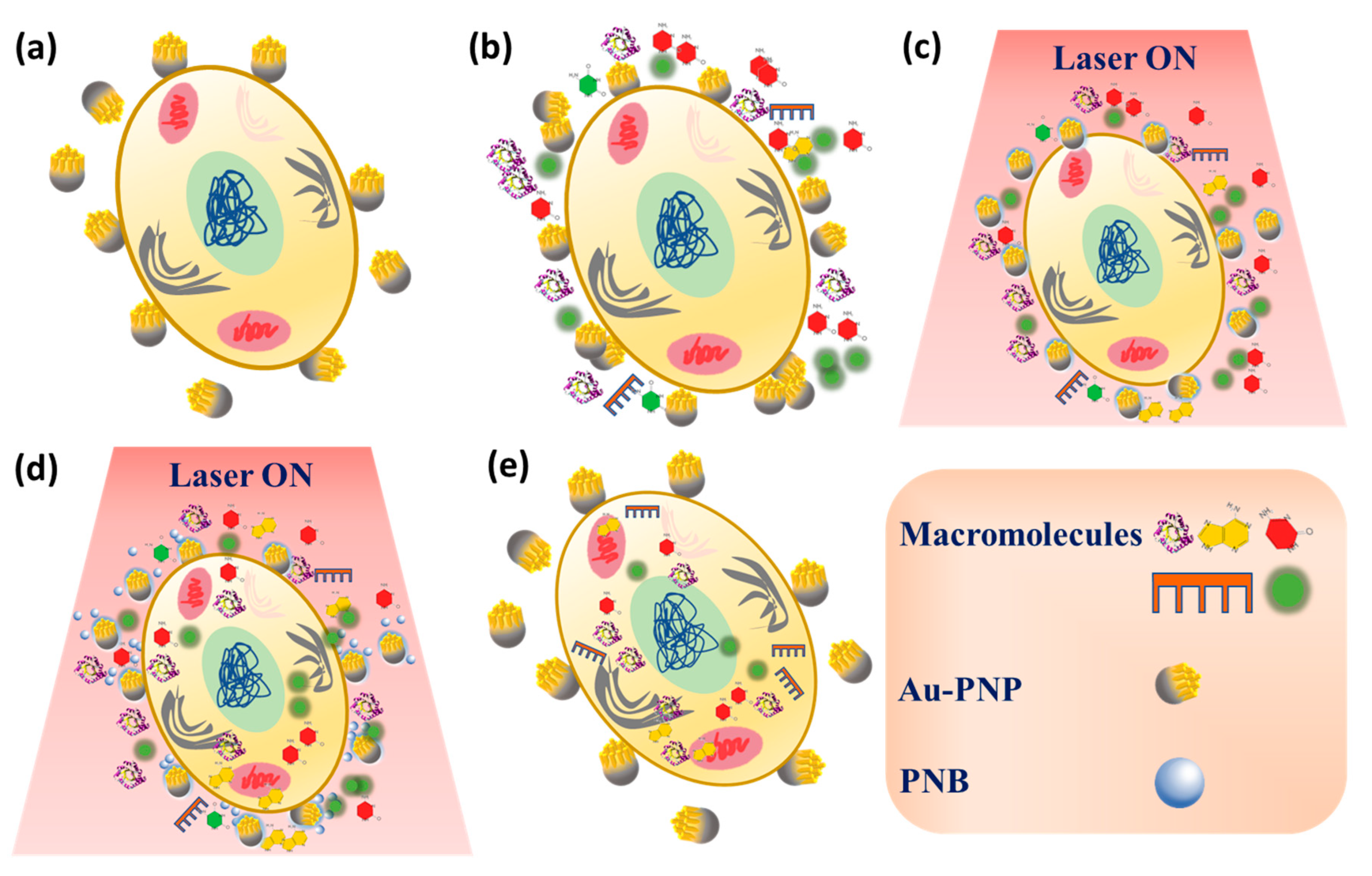
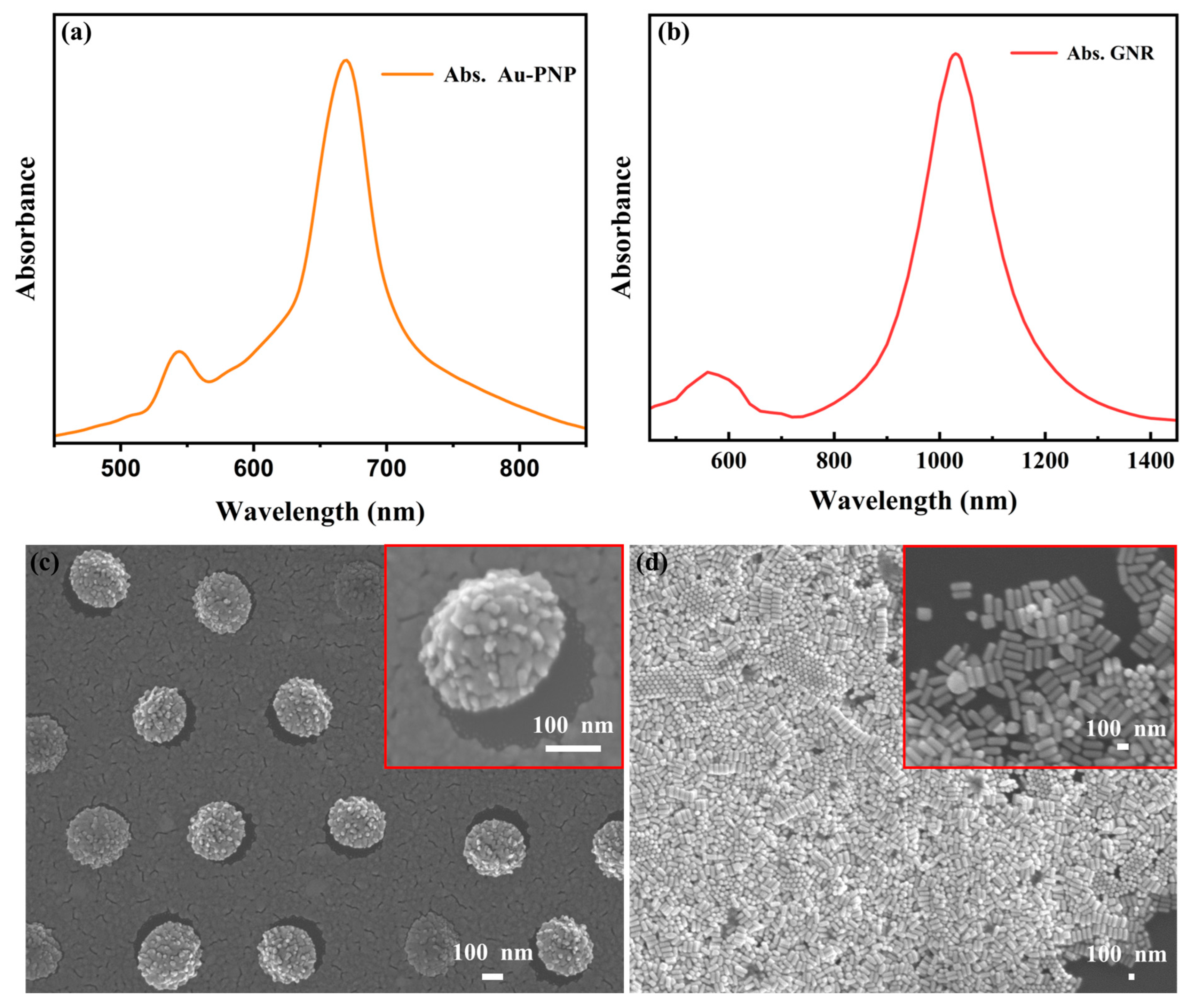
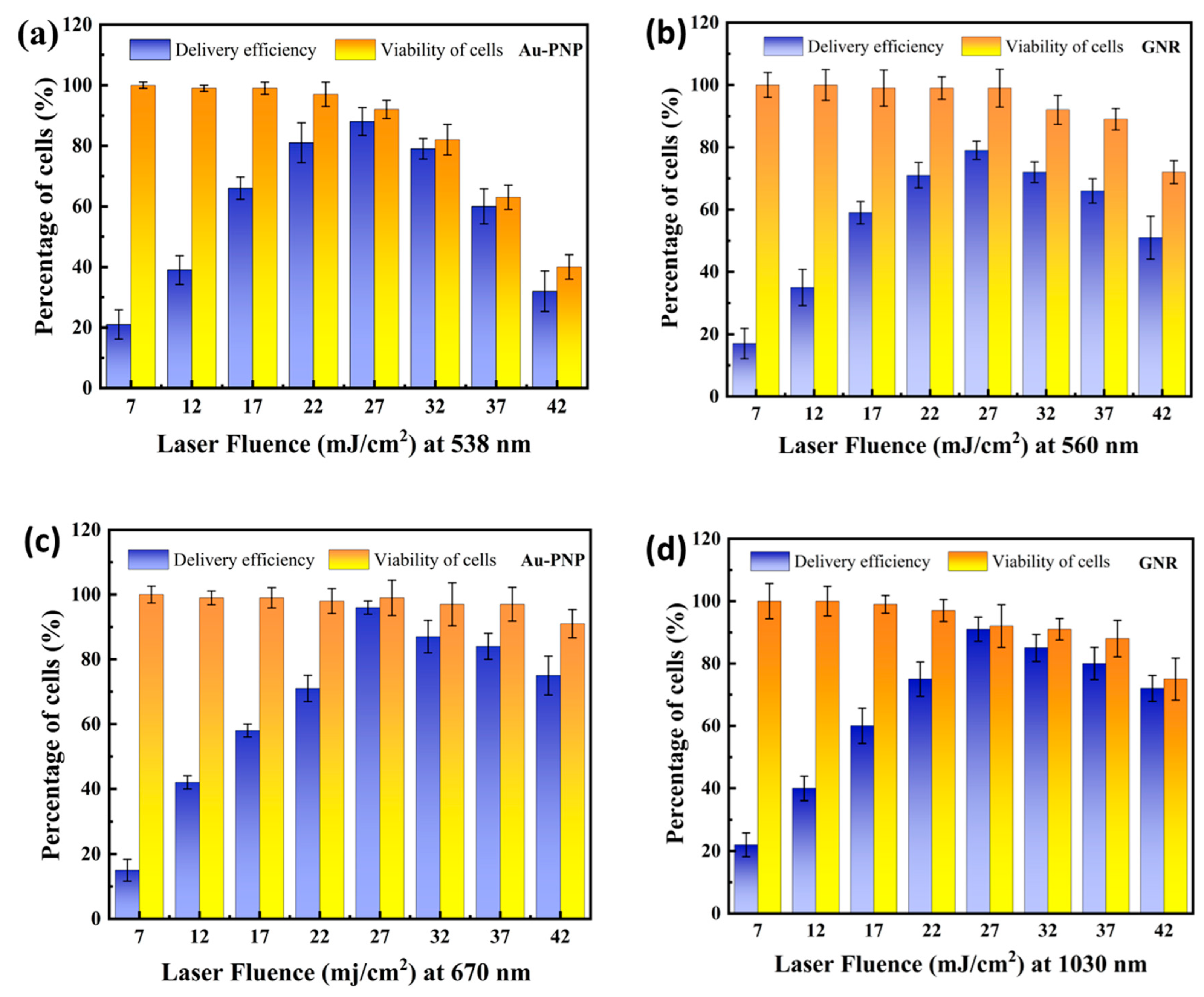

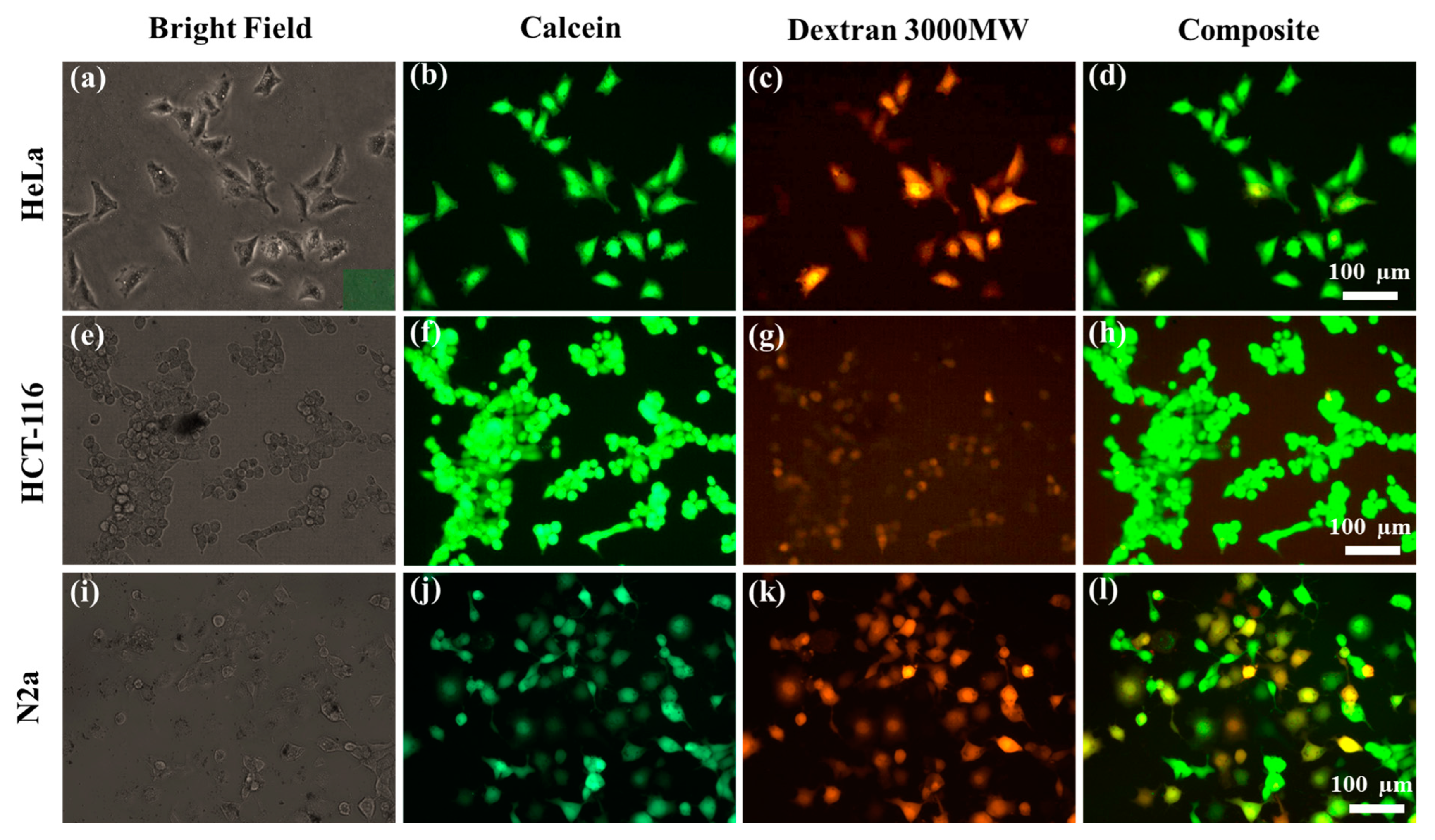
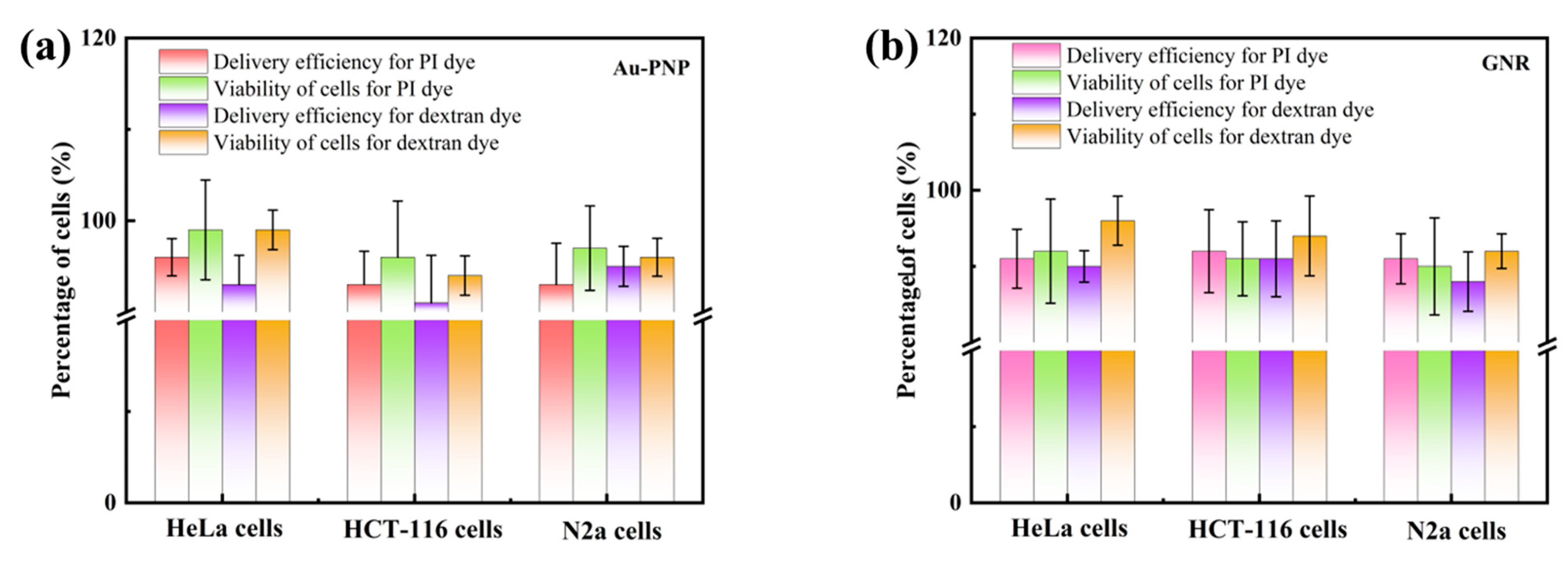
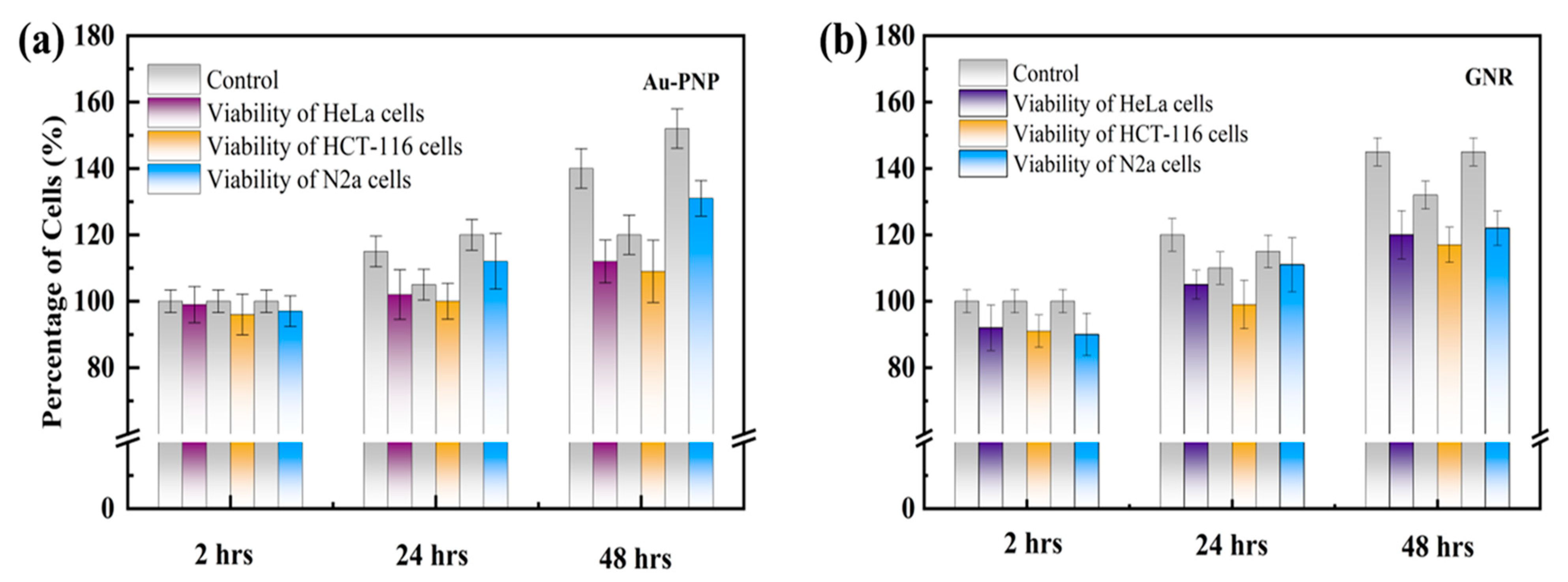
Disclaimer/Publisher’s Note: The statements, opinions and data contained in all publications are solely those of the individual author(s) and contributor(s) and not of MDPI and/or the editor(s). MDPI and/or the editor(s) disclaim responsibility for any injury to people or property resulting from any ideas, methods, instructions or products referred to in the content. |
© 2024 by the authors. Licensee MDPI, Basel, Switzerland. This article is an open access article distributed under the terms and conditions of the Creative Commons Attribution (CC BY) license (https://creativecommons.org/licenses/by/4.0/).
Share and Cite
Kumar, A.; Nahak, B.K.; Gupta, P.; Santra, T.S.; Tseng, F.-G. Laser-Induced Intracellular Delivery: Exploiting Gold-Coated Spiky Polymeric Nanoparticles and Gold Nanorods under Near-Infrared Pulses for Single-Cell Nano-Photon-Poration. Micromachines 2024, 15, 168. https://doi.org/10.3390/mi15020168
Kumar A, Nahak BK, Gupta P, Santra TS, Tseng F-G. Laser-Induced Intracellular Delivery: Exploiting Gold-Coated Spiky Polymeric Nanoparticles and Gold Nanorods under Near-Infrared Pulses for Single-Cell Nano-Photon-Poration. Micromachines. 2024; 15(2):168. https://doi.org/10.3390/mi15020168
Chicago/Turabian StyleKumar, Ashish, Bishal Kumar Nahak, Pallavi Gupta, Tuhin Subhra Santra, and Fan-Gang Tseng. 2024. "Laser-Induced Intracellular Delivery: Exploiting Gold-Coated Spiky Polymeric Nanoparticles and Gold Nanorods under Near-Infrared Pulses for Single-Cell Nano-Photon-Poration" Micromachines 15, no. 2: 168. https://doi.org/10.3390/mi15020168
APA StyleKumar, A., Nahak, B. K., Gupta, P., Santra, T. S., & Tseng, F.-G. (2024). Laser-Induced Intracellular Delivery: Exploiting Gold-Coated Spiky Polymeric Nanoparticles and Gold Nanorods under Near-Infrared Pulses for Single-Cell Nano-Photon-Poration. Micromachines, 15(2), 168. https://doi.org/10.3390/mi15020168







